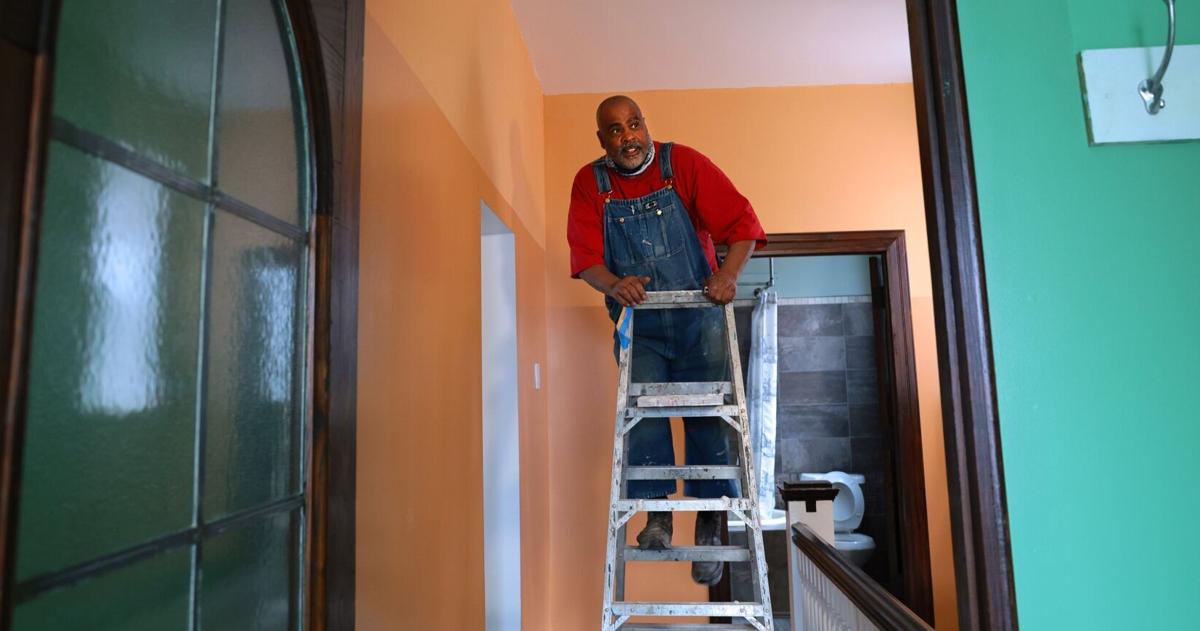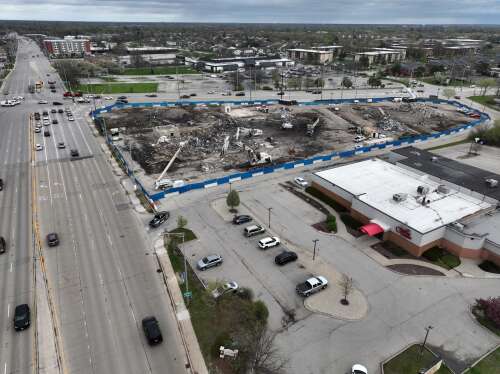ST. LOUIS — In June, a family bought the house across from the old St. James United Church of Christ, a 1911 brick converted two-family, for $300,000.
In most St. Louis-area neighborhoods, the sale would be unremarkable, perhaps noted among Zillow junkies as a good deal for its size.
But in far north St. Louis, where population decline, vacancy and the ensuing problems of drugs and violence have kept an unrelenting weight on a functioning housing market, the sale was unusual, particularly because the buyers were able to take out a mortgage on the College Hill neighborhood home.
Cole Hines, a U.S. Coast Guardsman transferred here more than a year ago from Duluth, Minnesota, said the price for the recently remodeled home of more than 4,000 square feet was hard to pass up. He and his wife needed plenty of space for their five children. They knew finding comparable sales for the house might be a challenge. But once the appraiser saw the house and the workmanship, he didn’t need any coaxing.
People are also reading…
“We didn’t have any troubles getting it appraised,” Hines said. “We thought we would, but we did not.”
This home on East College Avenue, rehabbed by College Hill neighborhood resident Johnel Langerston, sold for $300,000 in 2023.
The man who rehabbed the home, Johnel Langerston, is one of Hines’ new neighbors.
For Langerston, 60, the sale and mortgage represent a triumph after years of work in what was long regarded as one of the roughest neighborhoods in north St. Louis.
A resident of the neighborhood since 2012, Langerston’s work rehabbing several houses there has helped build on past investments, giving the northern end of College Hill, just a few hundred feet from O’Fallon Park, a far more intact feel than the streets closer to the historic water towers that serve as the neighborhood’s landmarks.
Along College Avenue, there’s the Mount Grace Convent of cloistered “Pink Sister” nuns and their well-maintained campus. There’s the mansion at the corner of Conde Street built 20 years ago by Eddie and Carmen Gamble and the smattering of new homes constructed over the past decade by a nonprofit arm of the Lutheran Church.
It wasn’t Langerston’s plan to become a rehabber and real estate investor. He wanted to run a basketball camp for kids, which he still does out of the gymnasium of the old St. James church where he lives with his wife. Langerston, an ex-con who did a stint in prison for drug trafficking, came to St. Louis from Oakland, California, after, his story goes, he searched online for the “worst place to live.” Langerston still runs a marketing company in California and used the proceeds to buy the old church.
He garnered a few headlines early on for his work running the basketball camp and its associated academic program. He says it has been a hit among kids and families in the surrounding neighborhoods.
“My focus is children,” Langerston said. “I stumbled into this.”
The real estate work started because of the house where the Hines live now. It was “drug-infested” when Langerston moved into the neighborhood, he said. A man who stayed there would try and hawk his product to mothers dropping off their kids at the church for basketball. Langerston confronted him one day, but the dealer told him that because he didn’t own the property, he could get lost.
“So I found the owners, and I bought it,” Langerston said. “I can’t tell you to move if I don’t own it.”
That was in 2015. He didn’t know much about home remodeling then.
Now, he sounds like a Realtor, showing off closet space and discussing how his interior home layouts “play” with natural light and incorporate exposed brick.
“Self-taught,” he said. “Lots of reading.”
Urban Born’s Johnel Langerston talks with a reporter Thursday, Feb. 8, 2024, inside a home he is working on in the College Hill area of St. Louis.
He’s bought several other houses from the city entity that takes title to abandoned properties, the Land Reutilization Authority. The homes and rehabs are concentrated along College Avenue and the surrounding blocks, an attempt to build some sort of momentum in a neighborhood beset by decline for decades.
“You can’t spread the comps out,” Langerston said.
He’s got a handful of finished rehabs under his belt now. Langerston turned the old parsonage next to the church into a bed and breakfast for a time and is showing it to new tenants now. Others he rehabbed and rented out. Some he sold, though he had to finance the buyers himself because the banks wouldn’t.
One of those houses, on Warne Avenue a block behind his home base at the church, has since sold again. The latest buyer was able to obtain a mortgage in 2022, real estate records show.
Progress, Langerston says.
The depopulation and vacancy in many north St. Louis neighborhoods becomes a devastating feedback loop, stoking crime and depressing property values. Reversing it is made all but impossible because of the largely nonexistent mortgage market on the north side. That keeps homeowners from obtaining the financing necessary to fix up the city’s historic brick housing stock, homes Langerston calls “remarkable.”
There have been ideas from nonprofits and public officials over the years to supplement private mortgages and push appraisers to widen their radius for comparable sales in order to breathe some life into the system. But change, especially in a city with a still-declining population that puts little upward demand pressure on housing, is slow.
Fewer than 7% of the 6,600 mortgages in the city in 2022 were north of Delmar Boulevard, according to the most recent data from the federal Home Mortgage Disclosure Act.
Until the Hines family’s appraisal and mortgage, Langerston said his other rehab sales weren’t financed with mortgages, shortchanging the remodeling craftsmanship he takes pride in.
“If you won’t give me my value, I’m locked out of the system,” Langerston said. “Inner-city people are locked out of the mortgage engine. How do we compete with a system that has us locked out?”
“He’s doing good work,” Hines said. “Not only the work he’s doing for the community, but he definitely provides a nice product with these homes and rehabs.”
Langerston is rehabbing another College Avenue house that he bought from the LRA in 2021. He already fixed up the house next door and rents it out. His current project, with a spacious front porch and open lots on both sides of the home, will sell for even more than the Hines’ home, he predicts. He’ll use the proceeds and keep chipping away in the neighborhood, buying a house here and there and fixing it up for new residents, some 600 of which — about a third of the neighborhood’s population — left between 2010 and 2020.
“So much more to go,” Langerston said.
‘A lot different neighborhood’
While the neighborhood has lost more than half of its population in the past 20 years, it has also become safer. A decade ago, St. Louis police Chief Sam Dotson saturated it with dozens of extra officers in a high-profile “hot-spot” policing experiment. Police held morning roll calls in the streets and walked its blocks in response to a rash of murders.
Whether it’s due to policing or depopulation, the violence has lessened. There were only three homicides in the past three years and none last year.
“It’s a lot different neighborhood than when I started there 12 years ago,” said Fred Kimbrough, who runs the College Hill Foundation that does neighborhood assistance work in the area. “We went from one of the worst in north city, and a lot of people may not know this, to one of the safest in the sixth (police) district.”
The foundation, affiliated with the Lutheran Church, funds home repair programs for neighborhood residents and has recently planted lavender gardens near Langerston’s properties. Several years ago, the Lutheran church built several new homes in the area, unmistakably modern structures sprinkled among the vacant lots and more classic century-old St. Louis brickwork.
Neighborhood resident Billy Butler joins volunteers harvesting thousands of lavender plants in the College Hill area of St. Louis on Thursday, June 16, 2022. This year, for the first time, Dierbergs is buying 600 of the resulting bundles.
In 2013, when the Lutheran nonprofit began building new homes, comparable sales topped out at $85,000. But the new houses cost around $200,000 to build. By the time the effort ended around 2020, the comps had risen to about $115,000, Kimbrough said.
Hopefully, Kimbrough said, the work helped lay a foundation for rehabbers like Langerston.
Hines, the new homeowner, is glad his family found their house. He and his wife got the standard St. Louis real estate advice to steer clear of the area and look on the south side, where they rented for a year while they searched for a home to buy. Now, they love their new neighborhood, and they feel safe there, he said. No, kids don’t trick-or-treat door to door yet. But he’s hopeful that will change.
“This doesn’t have to be what the media and what history has painted as the picture of this place, it doesn’t have to be like that,” Hines said. “We kind of envision a day when Halloween can be celebrated here.”
Josh Renaud of the Post-Dispatch contributed to this report.
Leonetta Nelson, a Hyde Park resident and contractor at Universal Build LLC, is glad to see community members come together at the Clean Up, Build Up event in College Hill on Saturday, Nov. 4, 2023. She said it gives hope and shows people that the neighborhood is “a beautiful place to live.” Video by Vanessa Abbitt, vabbitt@post-dispatch.com







